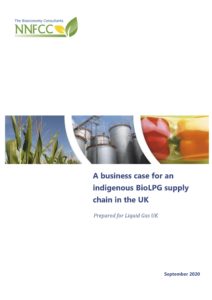 A new report released by Liquid Gas UK (LGUK), the trade association for the LPG industry in the UK, outlines how a green future for off-grid homes and businesses can be powered by household waste, woody biomass and used cooking oil.
A new report released by Liquid Gas UK (LGUK), the trade association for the LPG industry in the UK, outlines how a green future for off-grid homes and businesses can be powered by household waste, woody biomass and used cooking oil.
LGUK’s latest report, developed independently by leading bioenergy experts NNFCC, outlines the possible supply chain routes to create a thriving bioLPG production industry here in the UK, helping to provide green fuel solution for the 2.5 million off-grid homes and millions of businesses across the UK.
One of the leading technologies with the potential to produce around 368,000 tonnes of a mixture of bioLPG and low carbon LPG, annually is the conversion of up to 3 million tonnes of Refuse Derived Fuel (RDF), derived from residual household and similar waste that is currently exported internationally. The RDF would be turned into bioLPG/low carbon LPG through a process of gasification. An additional source of bioLPG could come from the 14.6 million tonnes of municipal solid waste that the UK sends to landfill each year.
George Webb, CEO, Liquid Gas UK commented, “Last year we outlined our vision to achieve net-zero and a 100% switch to bioLPG across the industry by 2040. Today’s report lays the marker for how that goal can be achieved by creating a thriving bioLPG supply chain here in the UK. Creating greener buildings was a key aspect of the governments recently announced 10-point plan for a green industrial revolution. Having multiple technologies feeding into the supply chains means that supply will become stronger by not having an over reliance on one key feedstock or a few facilities. The report also notes how bioLPG, unlike bioliquids, can be dropped into existing infrastructure, meaning that as the mix of bioLPG to LPG grows with new supply channels coming on stream, consumers can carry on using their existing boiler and tank systems.”
The NNFCC report also analysed other forms of bioLPG production from renewable sources, with woody biomass, particularly strong in Scotland, having the potential to produce 180,000 tonnes of bioLPG. Additional technologies that could be used to produce the fuel include the hydrogenation of cooking oils, one that is already operating at commercial scale, and isobutene production from existing sugar beet supply chains.
In order to develop this domestic supply chain, the report maps out existing and new facilities that will be needed. The utilisation of the six existing oil refineries located in the UK would provide an immediate and effective solution as they move towards renewable fuels, with bioLPG as a co-product from the processing. Complimenting these, the report proposes the development of wood-based bio refining in Scotland to utilise woody biomass and sawmill residues, as well as for household waste in England, to increase biofuel production for road and aviation, capturing bioLPG as a co-product.
The domestic production potential of bioLPG should be capitalised upon amidst global growth in demand for LPG, with production and consumption increasing from 315million tonnes in 2018 to 323million tonnes in 2019. With global demand on the upwards trend, domestic production of bioLPG will help the UK to secure its own supply of the fuel, as well as open the door to future exports.
Webb continued, “Our analysis shows that to develop the domestic production capacity we need an investment of between £1-2billion would be needed over the coming decades. As well as helping to produce over 1 million tonnes of bioLPG annually, such an investment will produce wider economic benefit, supporting over 500 jobs through the construction phase, as well as creating new jobs at the plants and utilising existing refinery capacity in a low carbon world.
“Already we are seeing huge investment from the industry over the coming years, with our members set to invest over £100m into bioLPG in the next five years, alongside £600m of investment in wider capex including storage and transport. The LPG industry is worth over £1bn to the UK economy and has strong growth potential making it primed and ready to work with government to deliver a bioLPG future. But to unlock the kind of investment needed to deliver UK production, we are reaching a tipping point where clear direction from government is needed as to the role of bioLPG in contributing to the UK’s net zero goal.”




Ramping up production of BioLPG production from the biomass treatment of organic waste in a closed biodigester, is an essential development to handle the huge amount of organic waste produced. As well as a feedstock for fossil free fuels it can be used to replace fossil methane for the production of hydrogen by steam methane reforming, as the 5 – 15% CO2 that escapes from this process will not contribute to atmospheric CO2 as the waste was originally derived from atmospheric CO2, when the plants etc grew. The methane can also be used to produce green hydrogen by cracking it directly with the Hazer process to hydrogen and carbon which is a carbon negative process. Capturing the CO2 from organic waste is very important to reduce the escape of methane into the air.